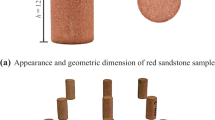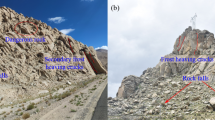Abstract
Freeze–thaw (FT) action is a major cause of rock deterioration in alpine regions. To explore damage evolution of sandstones in cold environment, artificial FT experiments were conducted in the laboratory. Saturated and dry sandstone specimens were subjected to 0, 7, 14, and 28 FT cycles. X-ray computed tomography (CT) images and 3D visualization were obtained to analyze changes in the inner microstructure along with FT cycles. Results show that the peak stress of sandstone decreases to different extents with the increasing number of FT cycles; compared with dry specimens, saturated specimens deteriorate more significantly and show obviously different stress–strain curves under loading. The saturated medium-grained sandstone (MGS) and fine-grained sandstone (FGS) specimens exhibit different damage patterns: initiation and coalescence of micro-cracks for MGS, and expansion and fusion of pores for FGS. Under the action of FT cycles, the frost heave of pore water causes initiation of micro-defects that mainly develop along relatively weak areas such as places close to inherent defects (pores and fractures) and boundaries between different mineral crystals, resulting in intergranular and transgranular cracking. For dry rock specimens, the non-uniform contraction and expansion of minerals are main causes for deterioration inside the rock. The porosity and elastic modulus were incorporated into a damage index to assess the evolving damage degree. The prediction is in good agreement with the developing trend of pores and micro-cracks and can effectively reflect the strength deterioration induced by cyclic FT actions.













Similar content being viewed by others
References
Amitrano D, Gruber S, Girard L (2012) Evidence of frost-cracking inferred from acoustic emissions in a high-alpine rock-wall. Earth Planet Sci Lett 341–344:86–93
Bayram F (2012) Predicting mechanical strength loss of natural stones after freeze–thaw in cold regions. Cold Reg Sci Technol 83–84:98–102
Cnudde V, Boone MN (2013) High-resolution X-ray computed tomography in geosciences: A review of the current technology and applications. Earth-Sci Rev 123:1–17
De Kock T, Boone MA, Schryver TD, Stappen JV, Derluyn H, Masschaele B, Cnudde V (2015) A pore-scale study of fracture dynamics in rock using X-ray micro-CT under ambient freeze–thaw cycling. Environ Sci Technol 49(5):2867–2874
Deprez M, Kock TD, Schutter GD, Cnudde V (2020) A review on freeze-thaw action and weathering of rocks. Earth-Sci Rev 203:103143
Dewanckele J, de Kock T, Boone MA, Cnudde V, Brabant L et al (2012) 4D imaging and quantificationof pore structure modifications inside natural building stones by means of high resolution X-ray CT. Sci Total Environ 416:436–448
Ge XM, Xiao YF, Fan YR, Liu JY, Zhang YH (2020) Laboratory investigation of the relationship between static rock elastic parameters and low field nuclear magnetic resonance data. Int J Rock Mech Min Sci 127:104207
Ge XR, Ren JX, Pu YB (2000) CT real-time test of mesoscopic damage propagation law of rock. Sci China Ser E 30(2):104–111
Hales TC, Roering JJ (2007) Climatic controls on frost cracking and implications for the evolution of bedrock landscapes. J Geophys Res Earth Surf 112(F2):F02033
Hasler A, Gruber S, Haeberli W (2011) Temperature variability and thermal offset in steep alpine rock and ice faces. Cryosphere 5(2):977–988
Hasler A, Gruber S, Beutel J (2012) Kinematics of steep bedrock permafrost. J Geophys Res: Earth Surf 117(F1):F01016
ISRM (1978) International society for rock mechanics. Suggested methods for determining tensile strength of rock materials. Int J Rock Mech Min Sci Geomech Abstr 15:99–103
Jaeger JC, Cook NGW, Zimmerman R (2007) Fundamentals of rock mechanics, 4th edn. Wiley-Blackwell, 488 pages
Jamshidi A, Nikudel MR, Khamehchiyan M (2013) Predicting the long-term durability of building stones against freeze-thaw using a decay function model. Cold Reg Sci Technol 92:29–36
Jia H, Ding S, Wang Y, Zi F, Yang G (2019) An NMR-based investigation of pore water freezing process in sandstone. Cold Reg Sci Technol 168:102893
Jia HL, Ding S, Zi F, Dong YH, Shen YJ (2020) Evolution in sandstone pore structures with freeze-thaw cycling and interpretation of damage mechanisms in saturated porous rocks. CATENA 195:104915
Kawamoto T, Ichikawa Y, Kyoya T (1988) Deformation and fracturing behavior of discontinuous rock mass and damage mechanics theory. Int J Numer Anal Methods Geomech 12(1):1–30
Jiang Q, Nakazawa N, Hu Y, Osako K, Okazaki E (2019) Changes in quality properties and tissue histology of lightly salted tuna meat subjected to multiple freeze-thaw cycles. Food Chem 293:178–186
Karpyn ZT, Alajmi A, Radaelli F, Halleck PM, Grader AS (2009) X-ray CT and hydraulic evidence for a relationship between fracture conductivity and adjacent matrix porosity. Eng Geol 103(3–4):139–145
Kawakata H, Cho A, Yanagidani T, Shimada M (1997) The observations of faulting in westerly granite under triaxial compression by X-ray CT scan. Int J Rock Mech Min Sci 34(3–4):151.e1–12
Ketcham RA, Slottke DT, Sharp JM (2010) Three-dimensional measurement of fractures in heterogeneous materials using high-resolution X-ray computed tomography. Geosphere6 (5):499–514
Khanlari G, Abdilor Y (2015) Influence of wet–dry, freeze–thaw, and heat–cool cycles on the physical and mechanical properties of Upper Red sandstones in central Iran. Bull Eng Geol Environ 74(4):1287–1300
Kodama J, Nakaya M, Nara Y, Goto T, Fukuda D , Fujii Y (2014) Observation of fracture process of rocks subjected to freeze-thaw cycles using X-ray CT. ISRM International Symposium-8th Asian Rock Mechanics Symposium 2014
Liu QS, Huang SB, Kang YS, Huang X (2015) Fatigue damage model and evaluation index for rock mass under freezing-thawing cycles. Chin J Rock Mech Eng 34(06):1116–2112
Louis L, Wong TF, Baud P (2007) Imaging strain localization by X-ray radiography and digital image correlation: Deformation bands in Rothbach sandstone. J Struct Geol 29(1):129–140
Luo X, Jiang N, Zuo C, Dai Z, Yan S (2014) Damage characteristics of altered and unaltered diabases subjected to extremely cold freeze–thaw cycles. Rock Mech Rock Eng 47(6):1997–2004
Martinez-Martinez J, Benavente D, Gomez-Heras M, Marco-Castano L, Garcia-Del-Cura MA (2013) Non-linear decay of building stones during freeze–thaw weathering processes. Constr Build Mater 38:443–454
Matsuoka N (1990) Mechanisms of rock breakdown by frost action: an experimental approach. Cold Reg Sci Technol 17(3):253–270
Matsuoka N (1995) Rock weathering processes and landform development in the Sør Rondane Mountains. Antarctica Geomorphology 12(4):323–339
Matsuoka N (2010a) Direct observation of frost wedging in alpine bedrock. Earth Surf Processes Landforms 26(6):601–614
Matsuoka N (2010b) Diurnal freeze-thaw depth in rockwalls: field measurements and theoretical considerations. Earth Surf Processes Landforms 19(5):423–435
Matsuoka N, Murton J (2008) Frost weathering: recent advances and future directions. Permafr Periglac Process 19(2):195–210
Murton JB, Peterson R, Ozouf JC (2006) Bedrock fracture by ice segregation in cold regions. Science 314(5802):1127–1129
Pan Z, Zhou K, Gao R, Jiang Z, Yang C, Gao F (2020) Research on the Pore Evolution of Sandstone in Cold Regions under Freeze-Thaw Weathering Cycles Based on NMR. Geofluids 10:1–12
Park J, Hyun CU, Park HD (2015) Changes in microstructure and physical properties of rocks caused by artificial freeze–thaw action. Bull Eng Geol Environ 74(2):555–565
Song YJ, Tan H, Yang HM, Chen SJ, Che YX, Chen JX (2021) Fracture evolution and failure characteristics of sandstone under freeze-thaw cycling by computed tomography. Eng Geol 294:106370
Sun Y, Zhai C, Xu JZ, Cong YZ, Qin L, Zhao C (2020) Characterisation and evolution of the full size range of pores and fractures in rocks under freeze-thaw conditions using nuclear magnetic resonance and three-dimensional X-ray microscopy. Eng Geol 271:105616
Terzaghi K (1967) Soil mechanics in engineering practice, 2nd edn. John Wiley & Sons, New York City
Tricart J (1956) Etude experimentale du probleme de la gelivation. Biul Peryglac 4:285–318
Tang MG, Xu Q, Deng WF, Chen X, Zhou J, Zhao HL (2022) The degradation law of mechanical properties of typical rock in Sichuan-Tibet Railway under freeze-thaw and unloading conditions. Earth Sci:1–16 https://doi.org/10.3799/dqkx.2021.260
Yan W, Sun J, Dong H, Cui L (2021) Investigating NMR-based absolute and relative permeability models of sandstone using digital rock techniques. J Pet Sci Eng 207:109105
Zhang HM, Wang H, Zhang JF, Cheng SF, Zhou HW (2020) Analysis of meso-damage characteristics of freeze-thaw rock on CT scale. J Liaoning Tech Univ (nat Sci Ed) 39(01):51–56
Acknowledgements
This study has been partially funded by Natural Science Foundation of Zhejiang Province (Grant No. LR19E090001), Natural Science Foundation of China (Grant No. 42077252), The Program of the State Key Laboratory of Frozen Soil Engineering (Grant No. SKLFSE-ZT-202110), and National Key R&D Program of China (Grant No. 2018YFC1505001). These supports are gratefully acknowledged.
Author information
Authors and Affiliations
Corresponding author
Ethics declarations
Conflict of interest
The authors declared that they have no conflicts of interest to this work. We declare that we do not have any commercial or associative interest that represents a conflict of interest in connection with the work submitted.
Rights and permissions
Springer Nature or its licensor holds exclusive rights to this article under a publishing agreement with the author(s) or other rightsholder(s); author self-archiving of the accepted manuscript version of this article is solely governed by the terms of such publishing agreement and applicable law.
About this article
Cite this article
Li, B., Zhang, G., Ma, W. et al. Damage mechanism of sandstones subject to cyclic freeze–thaw (FT) actions based on high-resolution computed tomography (CT). Bull Eng Geol Environ 81, 374 (2022). https://doi.org/10.1007/s10064-022-02872-z
Received:
Accepted:
Published:
DOI: https://doi.org/10.1007/s10064-022-02872-z




